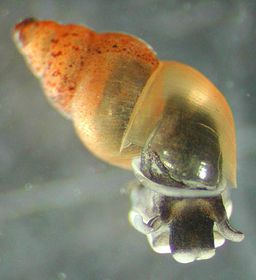 |
n/a | Status LU: established. 1st record: 1991. |
 |
Tiger-Floukriibs | Status Eur.: established. |
 |
n/a | RA: ISEIA: C2. Harmonia+: n/a. |
 |
Gefleckter Flussflohkrebs | Wikipedia: n/a (2020) | Wikispecies: n/a (2020) |
 |
Tijgervlokreeft | Back to the list of invertebrates |
Contents
Brief description
Gammarus tigrinus Sexton, 1939 has eliminated some native species in parts of the river Rhine and the Baltic Sea; it is frequently a superior predator in comparison to indigenous species.
See the copyrighted picture at cabi.org
Status and distribution in Luxembourg
Gammarus tigrinus Sexton, 1939 was first documented on 22 May 1991 in the Moselle river across from Bech-Kleinmacher, municipality of Schengen (Massard & Geimer 1992). Dhur (1993) showed that Gammarus tigrinus was present in the Moselle all the way from Schengen to Wasserbillig.
There is no distribution map available because no data has been entered into the Recorder-Lux database so far (MNHNL, iNaturalist & GBIF 2019).
Risk assessment
ISEIA protocol
C2 (3+1+3+1) (Ries et al. 2017: 68).
Harmonia+ protocol
Not assessed yet.
Worldwide distribution
Bibliography
- CABI, 2019. Gammarus tigrinus. In: Invasive Species Compendium. Wallingford, UK: CAB International. URL: www.cabi.org/isc [accessed 2020-03-13]
- Dhur, G., 1993. Étude des espèces d’invertébrés immigrées ou introduites dans la Moselle luxembourgeoise et dans les écosystèmes aquatiques qui en dépendent. Historique et répartition actuelle. Centre univ. Luxemb., Dép. Form. pédag., mém. sci., 213 pp.
- Dhur, G. & J.A. Massard, 1995. Etude historique et faunistique des Invertébrés immigrés ou introduits dans la Moselle luxembourgeoise et ses affluents. Bull. Soc. Nat. luxemb. 96: 127-156. [PDF 1896 KB]
- Massard, J.A. & G. Geimer, 1992. Découverte de Gammarus tigrinus Sexton, 1939 dans la Moselle frontalière entre le Luxembourg et l’Allemagne (Crustacea: Amphipoda). Bull. Soc. Nat. luxemb. 93: 195-198. [PDF 173 KB]
- Meisch, C. & J.A. Massard, 2015. Les recherches sur les crustacés (Crustacea) du Luxembourg : aperçu historique. Bull. Soc. Nat. luxemb. 116: 381-390. [PDF 1,22 MB]
- MNHNL, iNaturalist & GBIF, 2019. MNHNL-mdata, online portal combining species observation from Recorder-Lux, iNaturalist and GBIF. National Museum of Natural History, Luxembourg. URL: https://mdata.mnhn.lu [Accessed 2019-10-24]
- Ries, C., A. Arendt, C. Braunert, S. Christian, A. Dohet, A. Frantz, G. Geimer, M. Hellers, J. A. Massard, X. Mestdagh, R. Proess, N. Schneider & M. Pfeiffenschneider, 2017. Environmental impact assessment and black, watch and alert list classification after the ISEIA Protocol of invertebrates in Luxembourg. Bull. Soc. Nat. luxemb. 119: 63-70. [PDF 360 KB]
Page content last updated on 2023-09-27. Last proofread by Caroline Grounds on 2019-12-10.























